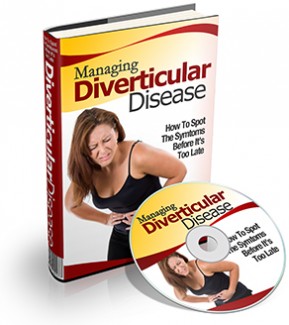 License Type: Private Label Rights
License Type: Private Label Rights  File Size: 18,731 KB
File Size: 18,731 KB File Type: ZIP
File Type: ZIP
 SKU: 52607
SKU: 52607  Shipping: Online Download
Shipping: Online Download
Ebook Sample Content Preview:
Complications of diverticular disease
Without the correct treatment, serious cases of diverticular disease can lead to:
Infection: Infection occurs when bodily fluids or faeces become trapped in the diverticula and begin to stagnate. This provides an optimal environment for the growth of bacteria and consequently, the development of infection.
Rectal Bleeding: Bleeding from the rectum can occur if diverticula present in the colon begin to bleed due to the bursting of a blood vessel.
Rectal bleeding will present itself in one of two ways:
Small amounts of blood will be present in the stool over a few days. This generally rectifies itself.
A large amount of blood is produced over a small amount of time, due to the bursting of a blood vessel. The onset of this type of bleeding is generally painless, immediate and accompanied by the urge to defecate. This symptom is usually only present in those with extreme cases of diverticulitis and requires hospitalisation and possible surgery. Alternatively, the implementation of a device up through the rectum to cauterise the bleeding wound shut. In some cases, the bleeding may stop spontaneously without the requirement of medical intervention.
Haemorrhage: The presence of rectal bleeding or bloody stools is generally indicative of internal bleeding or haemorrhage. Internal haemorrhaging will present itself as red or burgundy coloured stools.
Fistulas: A fistula is an abnormal tunnel or connection between two organs that develops as a result of infection. In the case of diverticulitis this infection is present with the inflamed diverticula.
There are many areas where fistulas can occur. The main areas affected by diverticular disease are the areas surrounding the bowel the genitals and the anus.
Fistulas may link the surrounding organs or cavities with the bowel. The most common occurrences in individuals with a gastrointestinal are as follows:
Enterocutaneous: Pathway leading form the gut, to the area of infection and finally to the skin.
Enteroenteric: Any fistula involving the intestines.
Enterovaginal: A fistula creating a pathway to the vagina. Symptoms of this fistula include vaginal discharge containing faecal matter. Feculent vaginal discharge can also be a result of a fistula developing between the sight of infection and the uterus.
Enterovesicular: A fistula creating a pathway form the site of infection to the bladder. Symptoms of the development of this type of fistula include frequent urinary tract infections, pneumaturia and the passing of gas from the urethra during urination.
In diverticular disease, the resultant fistulas are generally faecal or anal fistulas, meaning the fistula may cause faeces to pass through openings other than the anus. Fistulas are formed from abscesses which do not have a chance of healing due to being constantly filled with bodily fluids or stools. If these abscesses remain untreated they will consequently break through to the skin or another organ, creating a tunnel or connection between the two structures.
The types of fistulas that may develop include:
Blind fistulas- only one end of the fistula has an opening
Complete fistula- Both ends of the fistula are open
Horseshoe fistula- the anus is connected to the surface of the skin via a tunnel around the rectum.
Incomplete fistula- is only attached to one organ, generally the skin.
Symptoms of a fistula include pain, feeling ill, fever, tenderness or itching and severity will range depending on the location of the fistula itself.
Large Bowel Obstruction: This complication only occurs in a small number of individuals suffering from diverticulitis. As a result of the swelling due to inflammation scar tissue develops. Blockage due to inflammation will settle as the inflammation is treated, however blocking due to scar tissue remains. These blockages can occur as partial or total blockages. Partial blockages are not urgent, and therefore corrective surgery can be planned. Total blockages are urgent and must be addressed via surgery immediately.
Development of an Abscess: These are pus filled areas of infection and may form if initial infection remains untreated. Due to the destruction of tissue by an abscess, small holes known as perforations allow the leakage of pus out of the colon into the abdominal area. Perforations may cause the individual to develop pain in the back or lower extremities.
While small abscesses may rectify themselves without antibiotics, large abscesses may have to be drained. Abscesses are drained by inserting a catheter. If drainage is not successful, surgery may be required to clean the abscess.
If excessive amounts of infection leak out of the contaminated area into the abdominal cavity, peritonitis may occur. In this case, the individual will begin experiencing severe, generalised abdominal pain. Peritonitis refers to the infection of the walls of the abdomen and requires immediate surgery to clean the abdomen. Peritonitis can be fatal without treatment. Treatment involves an operation to clean the abdomen and infected parts of the colon are removed.
- File Size:18,731 KB
- License: Private Label Rights
- Category:Ebooks
- Tags:2014 Ebooks With Audio Private Label Rights








